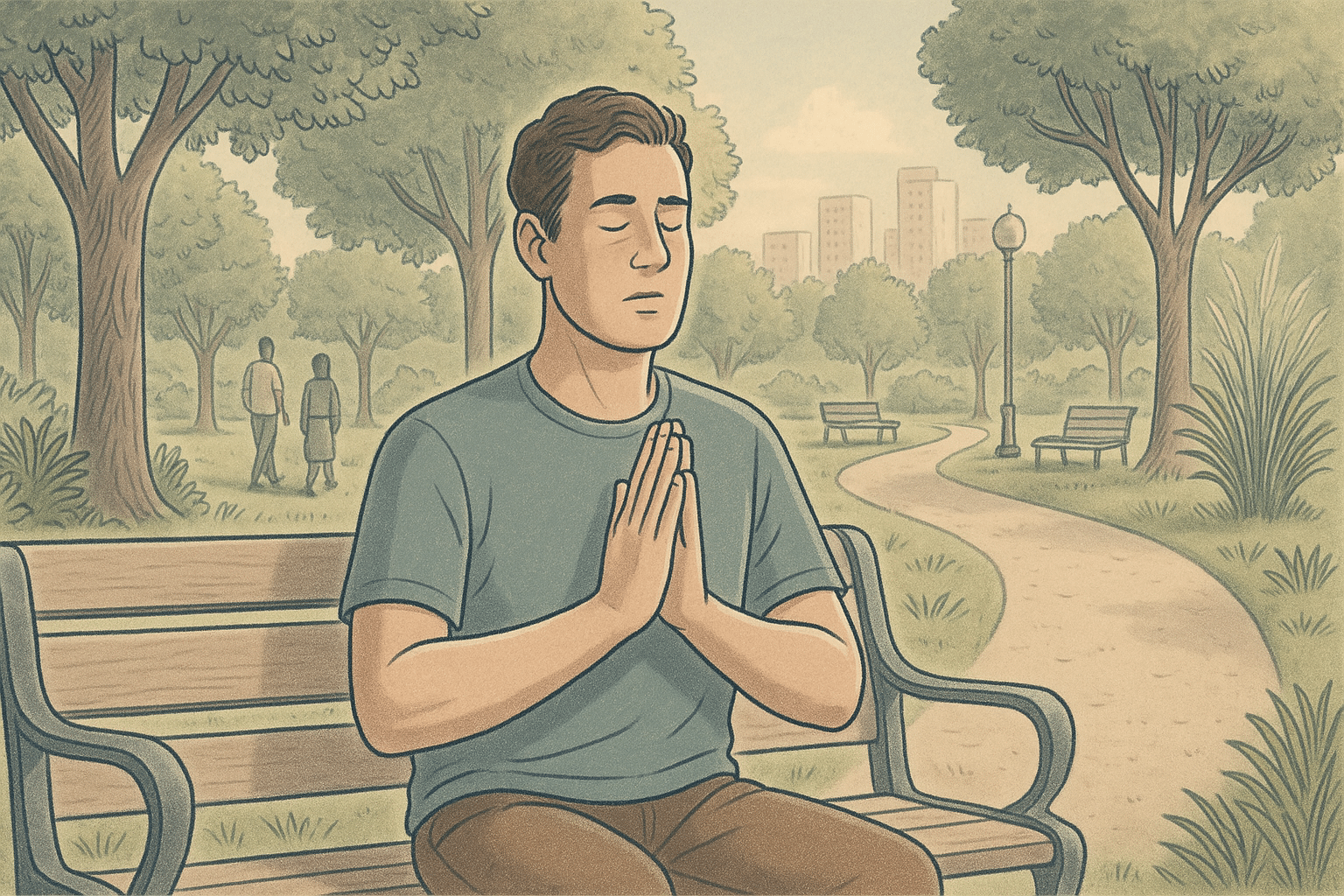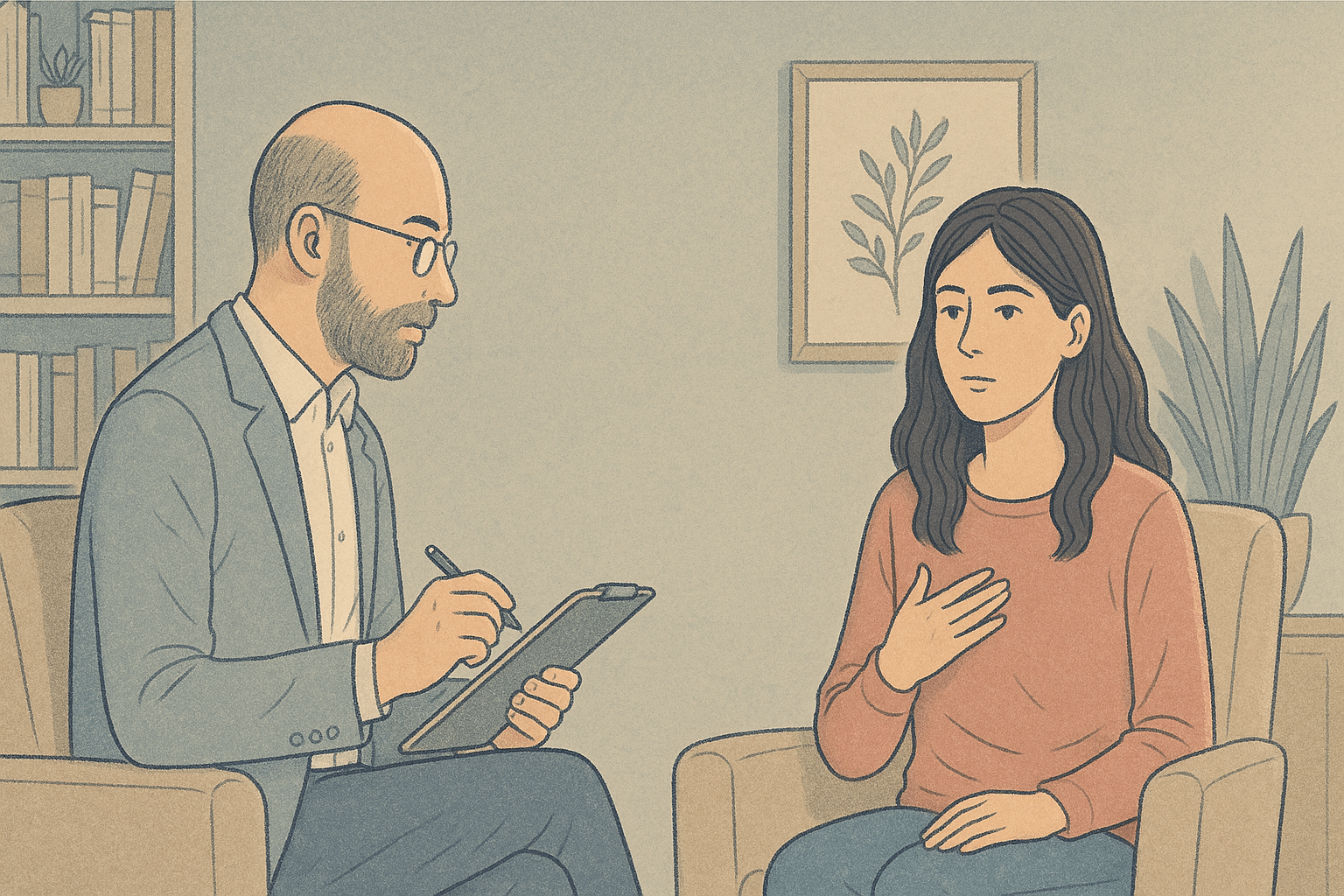Key Takeaways
- Recognizing panic attack symptoms early is crucial for implementing effective coping strategies in public settings.
- Deep breathing techniques like 4-7-8 and box breathing can quickly reduce the physical symptoms of a panic attack.
- Grounding exercises help reconnect you with your surroundings and interrupt the panic cycle when it feels overwhelming.
- Creating a personalized panic attack action plan before an episode occurs significantly improves your ability to handle the situation effectively.
- A Mission For Michael offers comprehensive panic attack treatment using evidence-based approaches including CBT, Exposure Therapy, and mindfulness techniques. AMFM’s comprehensive approach addresses both immediate symptoms and underlying causes, providing personalized care plans that empower you to build lasting resilience.
Panic Attack Symptoms
Before you can effectively manage a panic attack, you need to recognize one coming on. Panic attacks often strike suddenly and can escalate quickly, making early identification crucial for implementing coping strategies.
Physical Signs
You may experience shortness of breath or hyperventilation, feeling as though you can’t get enough air despite breathing rapidly. Sweating, trembling, and tingling in your extremities often accompany these symptoms, along with nausea or abdominal distress. These physical symptoms result from your body’s surge of adrenaline and can feel overwhelming, but they aren’t dangerous in themselves.
Mental Signs
Many people describe an overwhelming sense of dread or fear that something terrible is about to happen. You might experience a disturbing feeling of unreality, as though you’re detached from yourself or your surroundings (derealization or depersonalization). Some individuals also report a sudden fear of dying during these episodes, which, while unfounded, feels very real in the moment.
Duration of Attacks
Most panic attacks reach their peak intensity within 10 minutes of onset and rarely last longer than 30 minutes total. This knowledge alone can be comforting, knowing that regardless of how intense the feelings are, they will subside relatively quickly.
| A Mission For Michael: Expert Mental Health Care Founded in 2010, A Mission For Michael (AMFM) offers specialized mental health care across Southern California, Minnesota, and Virginia. Our accredited facilities provide residential and outpatient programs, utilizing evidence-based therapies such as CBT, DBT, and EMDR. Our dedicated team of licensed professionals ensures every client receives the best care possible, supported by accreditations from The Joint Commission and the California Department of Health Care Services. We are committed to safety and personalized treatment plans. Start your recovery journey with AMFM today! |
Breathing Techniques to Calm Panic Attacks

When panic strikes in public, your breathing is one of the first things to change, and one of the most powerful systems you can control to counter the attack.
4-7-8 Method
The 4-7-8 breathing technique is a powerful tool for quickly calming your nervous system during a panic attack. To practice this method, find a comfortable position where you can sit upright if possible.
Begin by exhaling completely through your mouth, making a whoosh sound. Then close your mouth and inhale quietly through your nose for a mental count of four. Hold your breath for a count of seven, then exhale completely through your mouth for a count of eight, again with the whooshing sound. This completes one breath cycle. Repeat this pattern three to four times initially, working up to more repetitions as you become comfortable with the technique.
Box Breathing
Box breathing, also known as square breathing involves four equal parts, like the sides of a box. Begin by slowly exhaling all the air from your lungs. Then inhale through your nose for a count of four, feeling your lungs fill completely. Hold that breath for another count of four. Exhale slowly through your mouth for a count of four. Finally, hold the empty breath for a count of four before beginning the cycle again.
The methodical, predictable pattern helps restore balance to your breathing while giving your mind something concrete to focus on other than panic sensations.
Deep Belly Breathing
Deep belly breathing activates your body’s relaxation response by engaging your diaphragm fully. Place one hand on your chest and the other on your abdomen just below your ribcage. Breathe in slowly through your nose, directing the air into your lower lungs so that your abdomen rises while your chest remains relatively still.
Hold briefly, then exhale slowly through slightly pursed lips, feeling your abdomen fall. Imagine filling a balloon in your belly with each inhale and deflating it with each exhale. This visualization helps maintain focus and proper technique.
Grounding Methods For Panic Attacks
Grounding techniques are particularly effective during panic attacks because they help break the cycle of escalating anxiety by redirecting your attention to the present moment.
5-4-3-2-1 Technique

The 5-4-3-2-1 technique engages all five senses to pull your attention away from anxious thoughts and back to your surroundings.
Start by acknowledging FIVE things you can see around you, perhaps the pattern on someone’s shirt, a light fixture, or text on a sign. Next, identify FOUR things you can touch or feel, the texture of your clothing, the pressure of your feet against the floor, or the temperature of the air on your skin. Then, notice THREE things you can hear, background conversations, the hum of air conditioning, or music playing overhead.
Acknowledge TWO things you can smell, perhaps someone’s perfume, coffee brewing, or the scent of your own hand lotion. Finally, identify ONE thing you can taste like a mint, the lingering flavor of your last meal, or simply the taste in your mouth. This comprehensive sensory exercise effectively interrupts the panic cycle by requiring mental engagement with your immediate environment.
Body Scanning
A body scan helps reconnect you with physical sensations beyond those caused by panic. Begin at the top of your head and slowly work your way down, mentally checking in with each part of your body. Notice any areas of tension or discomfort without judgment, and consciously try to release that tension as you move through the scan.
Pay particular attention to common tension spots like your jaw, shoulders, and hands, which often tighten during anxiety. This practice distracts from panic thoughts and helps identify and release physical manifestations of anxiety that might be perpetuating the attack.
Tactile Objects
Carrying a small tactile object can provide immediate sensory grounding during a public panic attack. This could be a smooth stone, a textured worry bead, a soft fabric swatch, or even a paperclip that you can manipulate with your fingers.
When panic begins, hold the object in your hand and focus intently on its physical properties, its weight, temperature, texture, and how it feels as you manipulate it. The physical sensation provides an anchor to the present moment and gives your hands something to do other than fidget anxiously, which can sometimes escalate physical symptoms.
Mental Strategies
Positive Self-Talk
Develop a set of personal mantras that works for you, such as “This is temporary and will pass,” “I’ve survived this before,” or “This is uncomfortable but not dangerous.” Speaking to yourself with compassion, as you would to a friend in distress, can be remarkably effective in calming your nervous system.
Reality Testing
When catastrophic thoughts arise, challenge them with reality checks. For example, if you’re worried about fainting in public, remind yourself that light-headedness during panic is caused by hyperventilation, not by a medical emergency, and that controlling your breathing will alleviate this symptom. Reality testing helps create distance between you and your thoughts, allowing you to observe them rather than being consumed by them.
Focusing Exercises
Mental focusing exercises redirect attention away from panic sensations and toward neutral or positive subjects. Try counting backward from 100 by 7s (100, 93, 86…), which requires enough concentration to distract from anxious thoughts. Another effective technique is to pick a category (like animals, countries, or movies) and list items alphabetically. These cognitive challenges occupy the same mental resources that would otherwise be devoted to anxious thinking, providing temporary relief that can help break the panic cycle.
When To Seek Help
Recurring Attacks

If you’re experiencing frequent panic attacks that interfere with your daily functioning or cause you to avoid important activities, seek professional help.
While occasional panic attacks are common, recurring episodes that significantly impact your life quality indicate a need for targeted intervention.
Pay particular attention if you’ve developed anticipatory anxiety (fear of having panic attacks) or if you’ve begun avoiding situations where escape might be difficult or embarrassing if panic occurs. This avoidance pattern, known as agoraphobia, can become increasingly restrictive over time if not addressed.
Professional Options
Effective treatment options for panic attacks include Cognitive Behavioral Therapy (CBT), which helps identify and change thought patterns that contribute to panic, and exposure therapy, which gradually desensitizes you to feared sensations and situations.
Many therapists now offer telehealth options, making treatment accessible even if mobility or anxiety makes in-person appointments challenging. Psychiatrists can evaluate whether medication might be helpful as either a short-term intervention during particularly difficult periods or as part of a longer-term treatment plan.
Mastering Public Panic: AMFM’s Path to Lasting Freedom
At A Mission For Michael, we understand that panic attacks represent more than moments of intense fear; they’re signals that your mind and body need specialized care and attention.
Our evidence-based treatment approach in our facilities at California, Virginia, and Washington combines proven therapeutic interventions like Cognitive-Behavioral Therapy and Exposure Therapy with other comprehensive strategies including mindfulness training and lifestyle modifications.

At AMFM, we don’t just teach you to survive panic attacks; we empower you to thrive beyond them.
Our personalized treatment plans recognize that every individual’s experience with panic is unique, requiring customized strategies that fit your specific triggers, lifestyle, and recovery goals. Through our comprehensive approach, clients develop immediate coping skills for public situations and long-term resilience that prevents future episodes and builds lasting confidence.
Don’t let panic attacks continue to limit your life or keep you from engaging fully in public spaces. Contact A Mission For Michael today to learn how our specialized anxiety treatment programs can help you transform panic from a controlling force into a manageable part of your past.
Frequently Asked Questions (FAQ)
How long do panic attacks typically last?
Most panic attacks reach their peak intensity within 10 minutes and resolve completely within 20–30 minutes. While this timeframe represents the typical pattern, individual experiences can vary, some people report shorter episodes lasting just a few minutes, while others experience waves of symptoms that may extend longer.
Can panic attacks cause physical harm?
Despite how frightening they feel, panic attacks themselves do not cause physical harm. The symptoms you experience during panic, racing heart, chest tightness, dizziness, shortness of breath, are the result of your body’s natural stress response and the surge of adrenaline that accompanies it. While these sensations can mimic serious medical conditions, they don’t cause damage to your cardiovascular system or other organs.
Should I take medication during a public panic attack?
If your doctor has prescribed fast-acting anti-anxiety medication specifically for panic attacks, using it according to their instructions can be appropriate during a public episode. These medications typically begin working within 15–30 minutes and can provide significant relief from intense symptoms. However, they should be used as prescribed, not as your only management strategy.
How does A Mission For Michael help people manage panic attacks effectively?
A Mission For Michael provides comprehensive panic attack treatment using evidence-based therapies including CBT, Exposure Therapy, and mindfulness techniques. AMFM’s approach addresses both immediate symptoms and underlying causes through personalized treatment plans, therapeutic interventions, lifestyle modifications, and breathing techniques.






